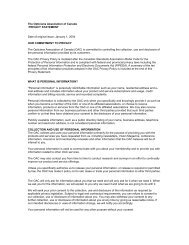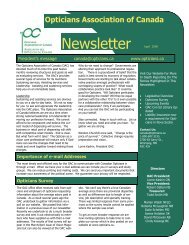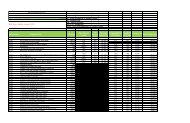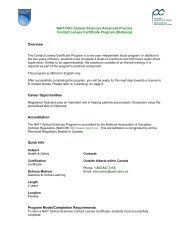vision + - Opticians Association of Canada
vision + - Opticians Association of Canada
vision + - Opticians Association of Canada
You also want an ePaper? Increase the reach of your titles
YUMPU automatically turns print PDFs into web optimized ePapers that Google loves.
Playing it Too Safe<br />
You might sleep soundly knowing that your money is<br />
invested in safe, income-generating vehicles such as Guaranteed<br />
Investment Certificates (GICs). But what about the<br />
money you’re not making by playing it excessively safe?<br />
Every individual has to determine the degree <strong>of</strong> risk<br />
with which they’re comfortable (see Vision magazine,<br />
March/April 2006), but if you’re a 40-year-old whose<br />
portfolio is in fixed income and cash, you’re simply<br />
playing it too safe.<br />
While safe, low-return investment vehicles, such as<br />
GICs, can play a role in a well-balanced portfolio,<br />
investors who want to meet long-term goals should also<br />
invest in higher return potential investments, such as<br />
equities.<br />
One rule <strong>of</strong> thumb for a moderately risk-tolerant<br />
individual is to allocate "110 minus your age" to<br />
equities. That means that a 40-year-old might have 70 per<br />
cent allocated to a mix <strong>of</strong> equity-oriented mutual funds.<br />
On the other hand, investors with short time horizons<br />
might be better <strong>of</strong>f with a very modest – if any – stake<br />
in equities.<br />
Having Unrealistic Expectations<br />
While it's normal to hope for the best from your<br />
investments, you could run into some serious long-term<br />
cash flow problems if you base your future financial plans<br />
on unrealistic assumptions.<br />
According to an August 2004 Gallup poll, nearly<br />
one-third <strong>of</strong> 800 U.S. investors surveyed expected to<br />
generate pr<strong>of</strong>its <strong>of</strong> 10 per cent or more in their portfolios<br />
during the coming year.<br />
Yet, based on data from Standard & Poor's and the<br />
U.S. Federal Reserve, from 1926 to 2003, a hypothetical<br />
portfolio divided equally among stocks, bonds and cash<br />
would have had an average total return <strong>of</strong> 7.3 per cent<br />
annually.<br />
Research the historical performance <strong>of</strong> appropriate<br />
investment indexes – or appropriate benchmarks – and<br />
use their average long-term returns to help maintain<br />
realistic expectations for your own investment returns. ISI
















